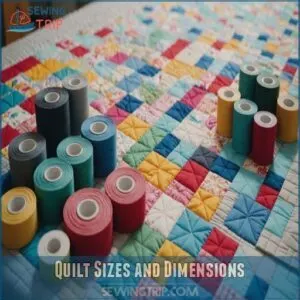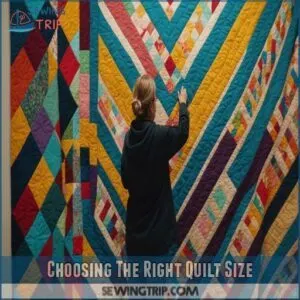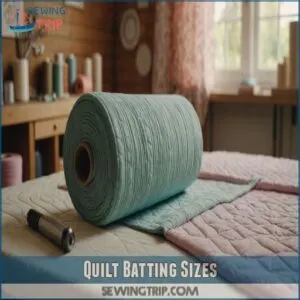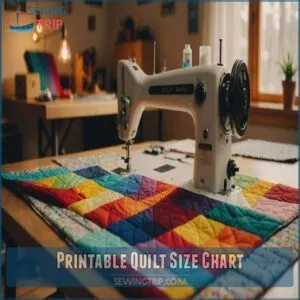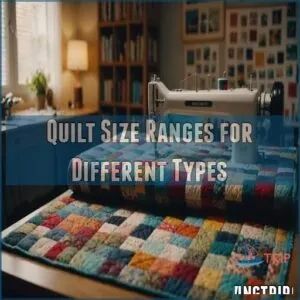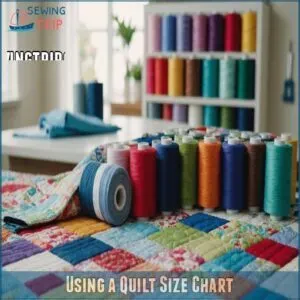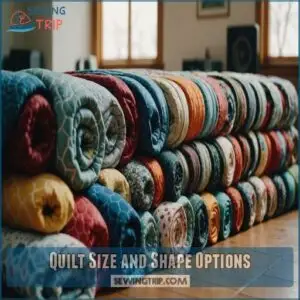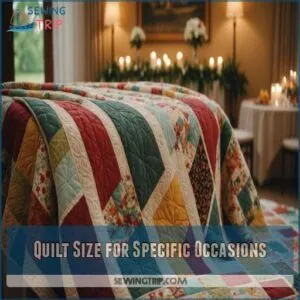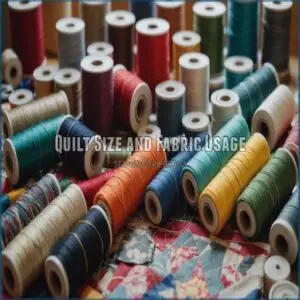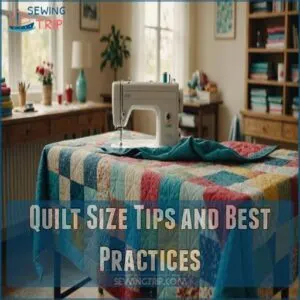This site is supported by our readers. We may earn a commission, at no cost to you, if you purchase through links.
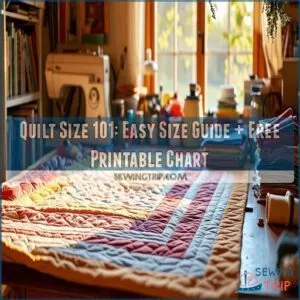
Standard quilt sizes range from a 70" x 90" twin to a luxurious 110" x 108" king.
Your bed isn’t the only factor at play, though—consider how much overhang you prefer and if your style leans toward more traditional or modern shapes.
For special occasions or everyday coziness, the right quilt size adds that perfect touch of warmth and charm. Ready to stitch your way to success? Dive deeper into perfect pairings and custom sizing!
Table Of Contents
- Key Takeaways
- Quilt Sizes and Dimensions
- Choosing The Right Quilt Size
- Quilt Batting Sizes
- Quilt Size Considerations for Different Beds
- A Brief History of Quilts and Quilting
- Quilt Size Chart and Dimensions
- Quilt Size and Shape Options
- Quilt Size for Specific Occasions
- Quilt Size and Fabric Usage
- Quilt Size Tips and Best Practices
- Frequently Asked Questions (FAQs)
- Conclusion
Key Takeaways
- You’ll need to consider your mattress size and how much overhang you want when choosing a quilt.
- Standard quilt sizes exist, but you can easily customize your quilt to fit your needs perfectly.
- A quilt size chart will help you determine the right dimensions for different bed sizes and occasions.
- You’ll need to account for batting size and fabric requirements when calculating the amount of fabric needed for your quilt.
Quilt Sizes and Dimensions
When figuring out quilt sizes and dimensions, you’ll soon find there’s no one-size-fits-all strategy, just like trying to fit your life story into a tweet.
Whether crafting a baby quilt or something grand for a king-sized bed, understanding standard sizes and factors like overhang will guide your creation from cozy to perfect.
Standard Quilt Sizes
Let’s explore the maze of standard quilt sizes.
Imagine matching quilt sizes with bed types like a perfect puzzle piece.
A great resource for exploring throw quilt size options can be found at throw quilt size guides.
Whether you’re covering a twin, queen, or king, dimensions matter—think 70"x90" for twins and 90"x108" for queens.
The size makes sure your quilt drapes elegantly.
Don’t forget quilt size trends and charts help you nail it every time!
Crib and Baby Quilt Sizes
You’ve learned about standard quilt sizes, now consider crib and baby quilts.
They’re more than just cute; they’re practical.
A safe crib quilt should be light and breathable, typically 36" x 52".
When determining the perfect size, consider the purpose of the quilt, such as a crib quilts guide.
Consider these factors:
- Safety first: prioritize breathable materials.
- Play with patterns for fun designs.
- Match fabric durability with baby needs.
Make your baby’s quilt both cozy and adorable!
Twin, Full, Queen, and King Quilt Sizes
Curious about quilt sizes?
Twin vs. full beds need different covers; twin quilts are 70"x90", while full is 85"x108".
Don’t skimp on king bed quilts—go for 110"x108".
A queen quilt size fits at 90"x108".
These choices, driven by your bed size impact, guarantee cozy nights and perfect quilt overhang.
Keep your quilt size chart handy!
Factors Affecting Quilt Size
While considering quilt sizes like twin or king, think about the factors that affect quilt dimensions beyond the standard options.
Quilt size hinges on quilt type, personal preference, and intended use.
A well-sized throw quilt can wrap you up just right!
Key elements include:
- Quilt overhang and drape
- Fabric choice and material
- Preferred quilting technique
Choosing The Right Quilt Size
Choosing the right quilt size is all about finding the perfect fit for your bed and your style!
Consider your mattress dimensions, how much overhang you want (think cozy cocoon versus crisp and clean), and remember, you can always customize the size to create your dream quilt.
Mattress Size Considerations
Picking the perfect quilt for your mattress is part art, part science.
Your quilt should match your mattress width and drape just right without going overboard.
Twin quilts, for instance, typically measure around 81 x 106 inches, making them ideal for twin-sized beds with mattresses ranging from 39 x 75 inches, which can be constructed using twin quilt block counts.
Custom sizing can make your quilt feel like it was made just for you.
Check out our handy table for a quick comparison:
| Mattress Type | Recommended Quilt Width |
|---|---|
| Twin | 70" |
| Full | 85" |
| Queen | 90" |
| King | 110" |
| California King | " |
This way, your blanket doesn’t just fit; it belongs perfectly!
Overhang and Drape Preferences
Think about how much quilt overhang you want.
Too little, your bed feels naked; too much, it’s like a toddler in dad’s shirt.
Aim for an overhang that just kisses the floor.
Consider your quilt’s weight and drape impact—some fabrics hug better than others.
Whether it’s a quilt size for couch cuddles or bed coziness, balance is key.
Customizing Quilt Size
Getting the quilt size just right is like Goldilocks finding her perfect bed.
A bit of math, such as using a quilt size equation, helps you balance overhang and drape preferences.
When planning your quilt, you can also refer to a quilt size chart online for guidance, such as those found on quilt size guides.
Consider your fabric needs and batting size, then toss in a quilt size calculator for good measure.
Customizing your quilt shape sets your style apart and suits your quilting style perfectly!
Quilt Batting Sizes
Choosing the right quilt batting size is a bit like picking the perfect sandwich bread—it’s essential for the whole shebang.
You’ll find batting in pre-cut packages, but sometimes trimming it to your specific quilt’s needs is just part of the fun.
Factors Affecting Batting Size
Switching gears from choosing the perfect quilt size, you’ll want to think about the batting thickness that works best for you.
This choice affects warmth, weight, and overall feel—key when snuggling or quilting for a toddler’s cozy nap.
Different quilting methods and styles demand varied batting for complexity and personal preference.
Your project’s specifics guide this sometimes overlooked decision.
Pre-Cut Batting Packages
Pre-cut batting packages can simplify your quilting life by offering ready-to-use options in various quilt sizes like crib or king.
Explore different batting package brands and materials like cotton or polyester, catering to your quilt size for bedding needs.
Here’s what to keep in mind:
- Batting package sizes make selection easy.
- Material types affect quilt comfort.
- Package cost fits most budgets.
Cutting Batting to Size
Many quilters find cutting batting a breeze!
First, measure your quilt top carefully, adding extra inches for batting overhang (about 4 inches is standard for most quilting techniques).
Use sharp scissors or a rotary cutter for clean cuts.
Remember, your quilt size impacts the amount of batting you need.
Don’t forget to account for quilt size for blocks and pattern placement!
Accurate cutting guarantees a beautiful, professional-looking finished quilt.
Enjoy the process!
Quilt Size Considerations for Different Beds
When you’re picking a quilt size for different beds, it’s a bit like fitting a pair of shoes—you want just the right amount of overhang to cover the toes, or in this case, the mattress.
Whether it’s the snug fit for twin and full beds, the generous drape of a queen, or the sprawling comfort of a king, each has its own personality, just like your favorite cozy bedtime read.
Twin and Full-Size Beds
Quilts for twin and full-size beds open up cozy possibilities. Whether you’re napping, cuddling, or decorating, the right size matters.
- Twin quilt size gives just the right overhang.
- Full quilt overhang keeps toes cozy and beds neat.
- Quilt size comparison helps decide between drape and snug.
- Don’t forget the fabric needs for each size; it’s craft time!
Queen-Size Beds
For queen-size beds, you’ve got to nail the quilt size.
Think about your overhang preferences—maybe a little extra for cozy snuggles or just enough to keep it neat and tidy.
Queen size quilts often need a bit more fabric, so plan those patterns!
Remember, the perfect quilt size turns decoration into delightful relaxation.
King-Size Beds
Picture your king-sized bed dressed in grandeur.
If you’re looking for the perfect king quilt size, check out websites that offer a variety of options like king quilt size products.
For the perfect quilt, consider these factors:
- Quilt Overhang: Allow extra fabric to drape elegantly over the sides.
- Bedding Style: Choose a design that complements your room’s vibe.
- Bedside Tables: Make sure the quilt fits without hiding your stylish tables.
Opt for king quilts that promise warmth and elegance.
A Brief History of Quilts and Quilting
You mightn’t know it, but quilts have a rich history that starts with early American colonists who patched together scraps out of necessity.
Over time, quilting has evolved into an art form, with intricate patterns and techniques that are as colorful and varied as your grandma’s yarn collection.
Early American Quilts
You might wonder how early American quilts fit into the puzzle of quilt sizes and styles.
These quilts, often crafted from fabric remnants using money and time saving quilting ideas like efficient fabric cutting and repurposed materials, reflect a rich historical context and showcase the quilting techniques of their time.
Imagine a table creating a patchwork story of its own:
| Aspect | Early American Quilts | Quilting Techniques |
|---|---|---|
| Fabric Choices | Scraps and remnants | Hand stitching |
| Quilt Patterns | Medallion and wholecloth | Block construction |
| Societal Impact | Community building | Skill sharing |
Evolution of Quilt Patterns
From simple wholecloth designs, quilting evolved as a craft that dates back to ancient civilizations where people used sewing techniques to create clothing, shelter, and tools.
Early quilt styles used readily available fabrics.
Patchwork techniques became popular, showcasing creativity with scraps.
Geometric patterns emerged, adding structure and visual interest.
The history of quilting is a vibrant tapestry, reflecting changing times and tastes.
Modern quilt trends continue this legacy, blending tradition with innovation.
Isn’t it amazing how a simple quilt can tell such a rich story?
Notable Quilt Styles and Techniques
As quilt patterns evolved, you might explore notable styles that showcase creativity and tradition.
Consider these varied techniques:
- Block patterns: A classic choice for both beginners and experts.
- Amish quilting: Known for its simplicity and beauty.
- Modern quilting: Bold, bright, unexpected.
- Hand quilting: Timeless and heartfelt.
- Lap quilts: Perfect for cozy evenings.
Each technique adds a unique touch to quilt making.
Quilt Size Chart and Dimensions
When you’re picking out or making a quilt, having a quilt size chart feels like finding a secret treasure map, guiding you to the perfect fit.
With a trusty chart in hand, you’ll easily match dimensions to any bed size, and maybe even avoid those hilarious moments where your quilt adventures off the edge of the mattress entirely!
Printable Quilt Size Chart
Imagine flipping through history’s quilt patterns to find clarity in sizes.
This downloadable chart gives you control over quilt dimensions with ease.
Grab this free printable as your quilt size guide for symmetry, sewing, and quilting.
Here’s a small teaser:
| Quilt Type | Size (in) |
|---|---|
| Baby | 36 x 52 |
| Twin | 70 x 90 |
| Queen | 90 x 108 |
| King | 110 x 108 |
Quilt Size Ranges for Different Types
Choosing the right quilt size feels like fitting the last piece of a puzzle.
Whether you’re lining up throw quilt sizes for the sofa or checking baby quilt dimensions, it’s all about matching needs.
Lap quilt sizes work great for cozying up, typically ranging from 36-50 inches in width and length as seen in lap quilt size guidelines.
A quilt size chart is your best buddy for getting dimensions just right.
- Throw Quilt Sizes: Perfect for sofas
- Baby Quilt Dimensions: Ideal for cribs
- Lap Quilt Sizes: Lap quilts are perfect for snuggling and can be made using 1 roll of jelly roll fabric, typically consisting of 40-42 pre-cut strips, jelly roll fabric strips. Best for snuggling
Using a Quilt Size Chart
Figuring out quilt dimensions can feel like solving a riddle, but a quilt size chart is your trusty map.
It helps you compare sizes and spot variations, though remember that charts mightn’t always be precise.
Here’s a quick guide:
| Quilt Type | Typical Dimensions |
|---|---|
| Crib | 36″ x 52″ |
| Twin | 70″ x 90″ |
| Queen | 90″ x 108″ |
This simplifies planning, ensuring your project fits snugly.
Quilt Size and Shape Options
When choosing the right quilt, you’ve got plenty of options, from classic squares and rectangles to quirky asymmetrical shapes and elegant medallions.
Imagine the endless creative adventures you can set out on with custom shapes, tailoring your quilt to fit any personal style or occasion.
Square, Rectangular, and Round Quilts
So, you’ve got your quilt size figured out? Great! Now let’s talk shapes. Square quilts are classic—think cozy and comfy. Rectangular quilts are versatile, perfect for beds of all sizes. Round quilts? They’re a fun statement piece!
Here are some ideas:
- Square quilt designs are timeless.
- Rectangular quilts fit most beds.
- Round quilt uses include wall hangings.
- Explore different round quilt patterns.
Asymmetrical and Medallion Quilts
Picture those crisp lines of square quilts reshaping into stunning asymmetrical quilt patterns or modern medallion designs.
They turn heads with creativity, echoing quilt history while showcasing fresh quilting techniques.
Choosing fabrics? Let your imagination run wild! Asymmetrical quilts invite spontaneity and flair, where your unique style takes center stage.
And who doesn’t love a project that breaks the usual mold?
Custom Quilt Shapes
You’ve conquered asymmetrical and medallion quilts.
Now, let’s venture into custom quilt shapes.
Think outside the box with unique designs like:
- Circles for a cozy round feel
- Hexagons for a modern twist
- Stars for a whimsical touch
- Triangles for dynamic flair
Custom shapes let your creativity shine.
Embrace quilting’s boundless possibilities!
Quilt Size for Specific Occasions
You know how some occasions just call for the perfect quilt, like baby’s first crib or a cozy anniversary gift?
Picking the right size adds a special touch, ensuring your quilt fits the moment as perfectly as a snug hug on a winter’s night.
Baby and Crib Quilts
While exploring quilt size and shape options, you might ponder how to wrap a little one in warmth and love.
Baby quilts typically two-stepping between coziness and cuteness make perfect gifts.
With baby quilt fabrics and charming crib quilt patterns, creating DIY crib quilts becomes more than a hobby—it’s a heartwarming journey.
Remember, the quilt size for newborns often speaks louder than words!
Lap and Throw Quilts
Dreaming of cozy evenings? A lap or throw quilt is your go-to for warmth and style, measuring around 50"x60". It’s perfect for snuggling on the couch or adding flair to a room.
Choose vibrant quilting patterns and playful fabric choices.
Get started with DIY tips to craft something uniquely yours.
Remember, every quilt tells a story, so make yours unforgettable!
- Warmth and style
- Couch snuggles
- Vibrant patterns
- Playful fabrics
- DIY creativity
Wedding and Anniversary Quilts
Imagine gifting a couple a quilt as unique as their love story.
Wedding and anniversary quilts are more than just blankets; they’re cherished keepsakes.
Personalize with fabric choices and quilt styles that echo the couple’s journey.
Incorporating creative designs adds a touch of humor and warmth.
This heirloom gift idea shows thoughtfulness but also adds lasting value.
Quilt Size and Fabric Usage
Ready to jump into the wonderfully wild world of fabric calculations?
Knowing your quilt’s size is the first step to figuring out how much fabric you’ll need—avoiding those dreaded last-minute fabric store dashes!
Calculating Fabric Requirements
When you’re figuring out how much fabric you’ll need for a quilt, don’t just wing it!
Consider the factors that affect fabric requirements:
- The fabric yardage and quilt block size.
- Fabric width to avoid unnecessary piecing.
- If pre-cut fabrics fit your vibe, they save time.
- Using scraps? Scrappy quilts can be stunning!
Think ahead to prevent last-minute fabric runs!
Fabric Usage for Different Quilt Sizes
You might think more fabric means more fun, but quilt size definitely impacts fabric yardage.
A quilt size chart comes in handy here.
For a precise calculation, understanding the differences between patchwork and quilting, such as quilting design techniques, can also play a significant role in determining the amount of fabric needed.
The pattern you choose also plays a role—complex ones like those from epic quilting legends could require even more fabric.
A quilt size chart comes in handy here.
The pattern you choose also plays a role—complex ones like those from epic quilting legends could require even more fabric.
Minimizing Fabric Waste
Nobody wants to waste fabric, especially when quilting.
Efficient cutting and clever pattern layouts help you keep scraps to a minimum.
Try using pre-cut fabric, which simplifies the process but also minimizes waste.
Embrace quilting techniques that make the most of every inch, turning leftover bits into charming patchwork or small projects, proving nothing goes to waste!
Quilt Size Tips and Best Practices
In terms of picking the perfect quilt size, think of it like choosing a pair of jeans—what fits just right can make all the difference.
You’ll want a quilt that covers your needs neatly, considering factors like batting, backing, and whether you’re a quilting newbie or a seasoned stitcher.
Measuring and Calculating Quilt Size
Calculating quilt size’s a bit like piecing together your fabric puzzle.
Start with the quilt size formula—think about your mattress size, overhang preferences, and desired drape.
Add extra to accommodate batting dimensions and sneak peek at that quilt size chart.
It’s like baking cookies; you adjust the dough for the right flavor.
Don’t forget fabric yardage!
Choosing The Right Batting and Backing
Picking the right batting and backing truly seals the deal on your quilt’s comfort and style.
Batting thickness and weight depend on your quilting style—go thick for coziness or keep it light for a summer feel.
Choose a backing fabric that compliments the quilt top and is slightly larger than the desired backing size, ensuring it extends at least 2-3 inches beyond the quilt top on all sides for easy quilt binding with backing. Choose a backing fabric that compliments the quilt top and is slightly larger than the desired backing size.
Quilt Size Considerations for Beginners
For your first quilt, starting small is smart.
A lap quilt (around 50" x 60") is manageable.
Remember to account for quilt shrinkage; pre-washing fabric helps.
Consider your quilting style’s impact on the final size.
Don’t stress over perfect sashing width options or border size decisions—have fun!
Frequently Asked Questions (FAQs)
Are there standard quilt sizes?
Imagine a world where every quilt size perfectly fits your bed dreams.
While toddler quilts come in various sizes, such as crib vs twin, with crib-sized quilts being extremely practical for crib-sized beds, toddler bed quilt dimensions. While there’s no one-size-fits-all, standard quilt sizes exist for cribs, twins, queens, and kings.
Yet, customizing your quilt guarantees a snug, unique fit.
What is a quilt size chart?
It’s a handy guide showing common quilt dimensions.
You’ll find sizes for cribs, twins, queens, and kings, plus throws.
It helps you plan your next cozy project, ensuring a perfect fit.
How big is a twin quilt?
Stitching dreams, a twin quilt typically measures 70” x 90”, just right for a cozy night.
It drapes neatly over a twin bed, offering warmth with a touch of charm.
Perfect for snuggling up with a book!
How big is a baby quilt?
A baby quilt often measures 36" x 52".
It’s just the right size to keep your little one cozy without overwhelming their cute space, though smaller sizes like 30" x 40" work for tiny cribs.
What are the sizes of quilts?
Picture your bed as a canvas, ready for a quilt masterpiece!
Crib quilts are 36"x52", twins 70"x90", queens cozy up to 90"x108", and kings take the crown at 110"x108".
Customize for your mattress.
What is the largest size quilt?
A king-size quilt is your ticket to maximum comfort.
It has dimensions typically around 110" x 108".
It’s perfect for those sprawling king beds, giving you that cozy, tucked-in feeling like a warm embrace on chilly nights.
What is the best size quilt for a queen bed?
Did you know a whopping 80% of queen-size quilts measure 90” x 108”?
You’ll want enough overhang for that comfy, tucked-in look.
Imagine snuggling under your new quilt with your feet never peeking out!
What are the quilt codes?
Quilt codes often refer to fabric patterns or specific stitching designs within quilting communities.
They’re like secret languages quilters use—imagine swapping quilt recipes.
These codes can help you follow complex instructions or create recognizable themed.
How do quilt sizes affect design choices?
Larger quilts let you go wild with intricate patterns.
Smaller ones need simpler designs.
Think of it like this: a tiny canvas needs a simple painting, while a huge one allows for a masterpiece.
Your quilt’s size directly impacts the complexity of your design, and it’s all about scale, like a simple painting versus a masterpiece.
What fabrics work best for custom quilts?
Imagine picking ingredients for a cake; cotton, linen, and are ideal fabrics for custom quilts.
They’re breathable, durable, and easy to work with.
Mixing textures—like a bit of cotton and silk—creates cozy, beautiful designs.
How to calculate quilt size for a round bed?
For a round bed, you’ll need a circular quilt with a diameter that matches the bed’s diameter plus an extra 10-inch overhang for drape.
Measure from one side of the bed to the other for accuracy!
How does climate influence quilt thickness?
Quilt thickness really depends on your climate.
In chilly areas, go for thicker quilts, packed with extra insulation.
But if you’re in a warmer place, lighter quilts with breathable fabrics are your best bet.
Stay cozy!
Can quilts be resized easily after finishing?
Ever wondered if resizing a finished quilt is a piece of cake?
It’s not exactly easy-peasy!
Altering a quilt can be tricky, often requiring removing stitches and adding fabric, which might affect the original design.
Conclusion
Quilting is all about the details, and understanding quilt size 101 helps you nail it every time.
By considering bed dimensions, overhang preferences, and special occasions, you can craft the perfect quilt that fits like a glove.
Whether you’re making a cozy baby quilt or a grand king-size masterpiece, this guide aids in choosing the right materials and size.
Now, you’re all set to turn quilting into an artful adventure!

